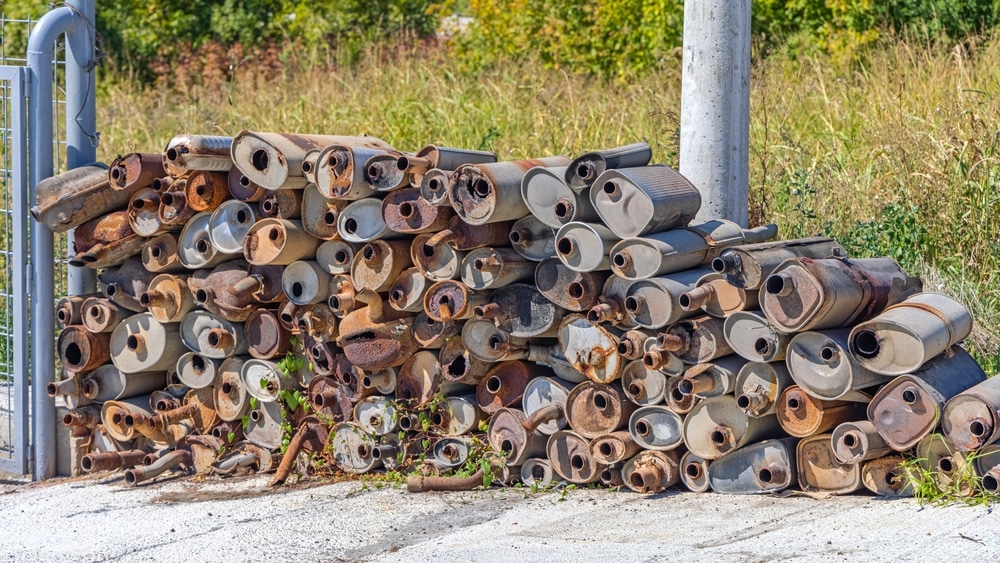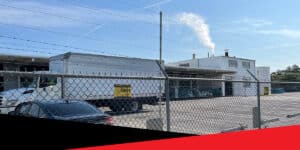Catalytic converter theft remains a threat as thieves target valuable vehicle components more frequently. According to the National Automobile Dealers Association, catalytic converter theft increased by 900% between 2019 and 2023.
Catalytic converters are a part of a vehicle’s exhaust system, located between the engine and the muffler, and are designed to defend against air pollution from vehicles, according to cars.com. If you own a cargo or trucking yard, auto salvage lot, or metal recycling facility, you are likely already aware of the spike in catalytic converter theft. These components contain precious metals that have become increasingly attractive to thieves looking to make a quick profit.
This article explores why criminals target these essential components and how perimeter security measures can help your business prevent catalytic converter theft.
Why Do People Steal Catalytic Converters?
People steal catalytic converters for three primary reasons: the high value of precious metals inside them, the ease and speed of theft, and market demand driven by global emissions regulations.
1. Valuable Precious Metals Inside
Catalytic converters contain three rare, expensive metals:
- Platinum
- Palladium
- Rhodium
These metals can often be worth more per ounce than gold.
A single stolen catalytic converter can fetch anywhere from $25 to $1,000 when sold to scrap metal dealers, who extract and resell the metals. Converters from hybrid vehicles typically sell for even higher amounts because they contain a larger concentration of precious metals.
2. Ease and Speed of Removal
Catalytic converters are located underneath vehicles in the exhaust system. This makes them easily accessible, which also makes them vulnerable. An experienced thief can remove a catalytic converter in as little as 30 seconds. This quick removal time is a major incentive for criminals.
Trucks, SUVs, and buses are primary targets because their higher ground clearance provides easier access to the undercarriage.
3. Market Demand and Prices
Global emissions regulations have created a higher demand for catalytic converters. Stricter air pollution standards in the United States have required manufacturers to produce more converters, driving up the market value of the precious metals inside them.
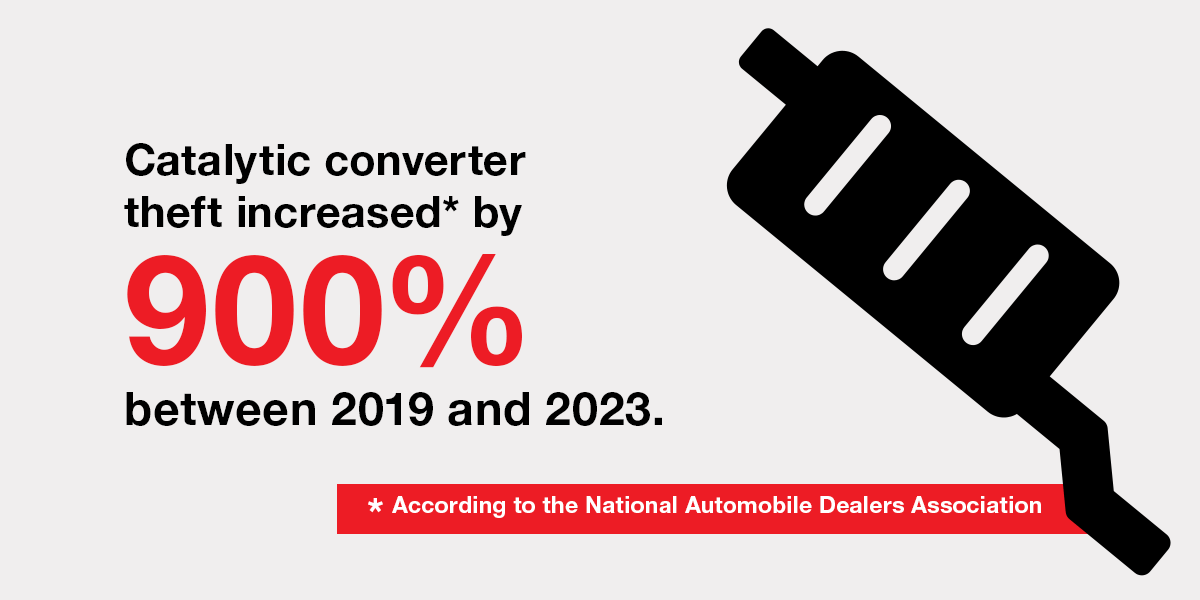
How Do People Steal Converters?
Thieves employ various tactics to gain access to lots and garages to steal catalytic converters, including:
- Scouting locations during business hours to identify security vulnerabilities
- Targeting remote areas of parking lots or properties with poor lighting
- Using lookouts or multiple vehicles to load and transport stolen converters quickly
- Attempting entry through weak points in perimeter security
- Operating during off-hours when properties are most vulnerable
Negative Impacts of Catalytic Converter Theft on Businesses
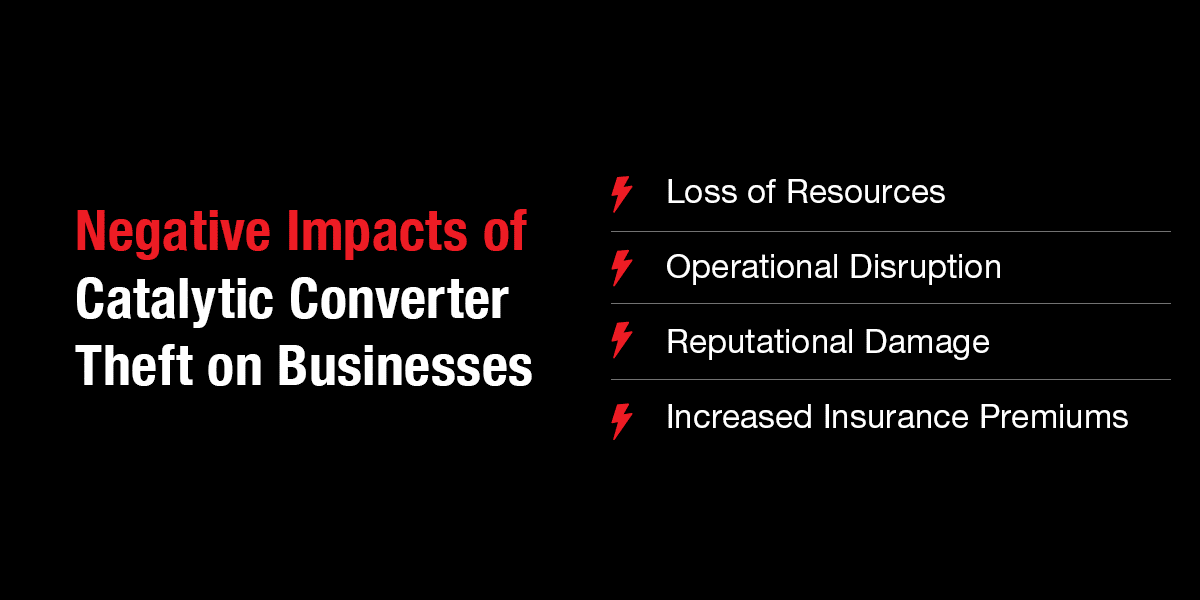
Catalytic converter theft can have severe consequences extending far beyond the cost of replacing the stolen parts. The negative impacts include:
Loss of Resources
Businesses lose valuable time and money filing police reports as well as attempting to locate the converter or find a replacement. Replacing a catalytic converter can cost up to $2,000, and that’s if the parts are even available. With the increased demand, these parts can take up to eight months to receive.
Operational Disruption
Trucking and delivery businesses suffer from lost productivity while vehicles are out of commission for repairs. Inoperable fleet vehicles cause delivery delays and scheduling complications. Additionally, reduced vehicle availability impacts customer service.
Reputational Damage
Theft incidents can damage a business’s reputation, making customers question the safety and security of the premises. This perception can lead to a loss of trust and reduced patronage, which impacts profits.
Increased Insurance Premiums
As theft claims mount, businesses may face higher insurance premiums. Insurers view properties with repeated incidents as riskier, leading to more expensive coverage or policy cancellations in extreme cases.
How to Stop Catalytic Converter Theft on Your Property
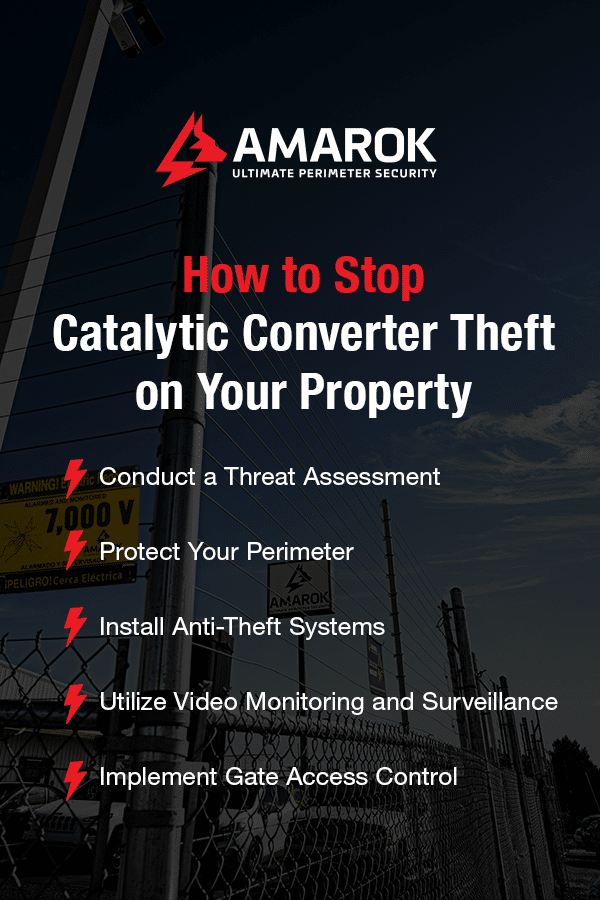
Preventing catalytic converter theft requires a multi-layered perimeter security approach. By implementing a combination of deterrents and theft detection measures, businesses can reduce their risk of falling prey to this costly crime.
Conduct a Threat Assessment
Identifying vulnerabilities is the first step to securing your property against catalytic converter theft. A thorough threat assessment will pinpoint areas where criminals may exploit weaknesses to gain access to steal catalytic converters. Evaluate your site layout and assess existing perimeter security measures. Consider factors such as lighting, video surveillance coverage, and access points.
Once you understand your unique security risks, work with an AMAROK expert to customize the ultimate perimeter security solution that addresses your specific vulnerabilities.
Protect Your Perimeter
Securing your perimeter prevents criminals from accessing your property to steal catalytic converters. An electric security fence creates a formidable barrier that deters would-be thieves — stopping theft before it happens. Electric fencing provides a visual deterrent using prominent warning signs that promise a 7,000-volt shock. Would-be intruders who do not heed these warnings receive a safe but memorable pulsed electric shock.
Install Anti-Theft Systems
Integrating bright lights and loud sirens can further deter external theft. When someone attempts to breach the perimeter, security lights flood the area with ultra-bright illumination, and siren sounds are emitted. When triggered, these systems draw attention to their location, increasing the likelihood that they will flee before causing damage.
Install alarm-based security lights where catalytic converter theft is most likely to occur, such as parking lots or vehicle storage yards. This illumination can make criminals more visible to security cameras as well as passing witnesses.
Utilize Video Monitoring and Surveillance
Cameras can help deter criminal activity by 13% and result in a 51% decrease in crime in parking lots. Thieves are often discouraged by visible video surveillance systems, knowing their actions and identities are on record.
When integrating video surveillance systems, prioritize coverage of high-risk areas such as parking lots, loading docks, and storage facilities. As an added advantage, surveillance footage can aid in quicker resolution of theft incidents and help you identify suspects. When integrated with remote monitoring services, these systems provide real-time alarms and enable swift response to potential threats.
Implement Gate Access Control
For trucking or transport industry businesses, controlling access to your property is crucial for preventing catalytic converter theft. Implementing a Gate Access Control system can help you monitor who enters and exits your property. It can also deter criminals from scouting locations and quickly identify perpetrators if a theft occurs.
A comprehensive access control solution should include features such as:
- Credential readers for secure entry and exit
- Video intercom systems for visitor verification
- License plate recognition cameras for vehicle tracking
- Integration with your perimeter security system
Restricting unauthorized access and maintaining a detailed log of all property visits can improve site security, reducing the risk of external theft.
Partner With AMAROK to Prevent Catalytic Converter Theft
Catalytic converter theft is a significant threat to businesses, leading to costly repairs, lost productivity, and potential reputational harm. As this crime trend continues, a multi-layered security strategy is essential for asset protection.
AMAROK is an award-winning, industry-leading perimeter security solutions provider. We offer innovative industrial and perimeter protection that stops would-be thieves in their tracks. AMAROK’s integrated security solution FORTIFEYE™ combines the strength of The Electric Guard Dog™ Fence with remote video monitoring and surveillance technology.
Protect your business from external theft. Contact us online to request a threat assessment for your property.
